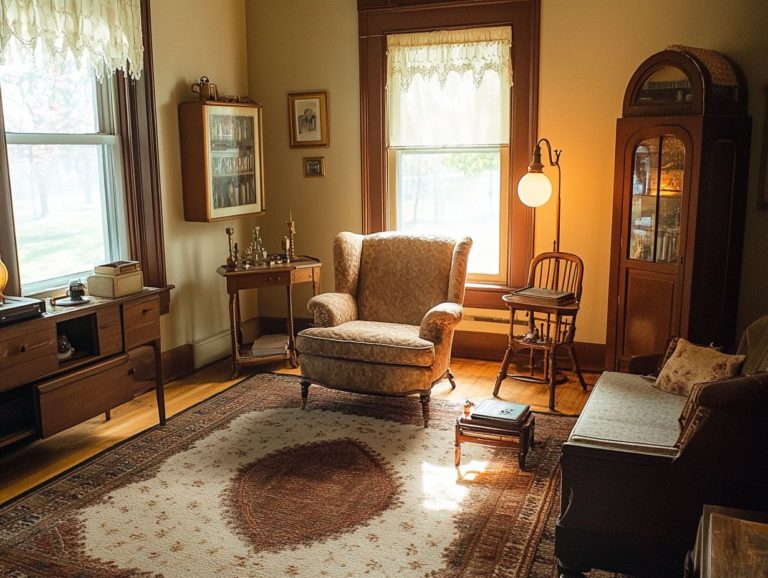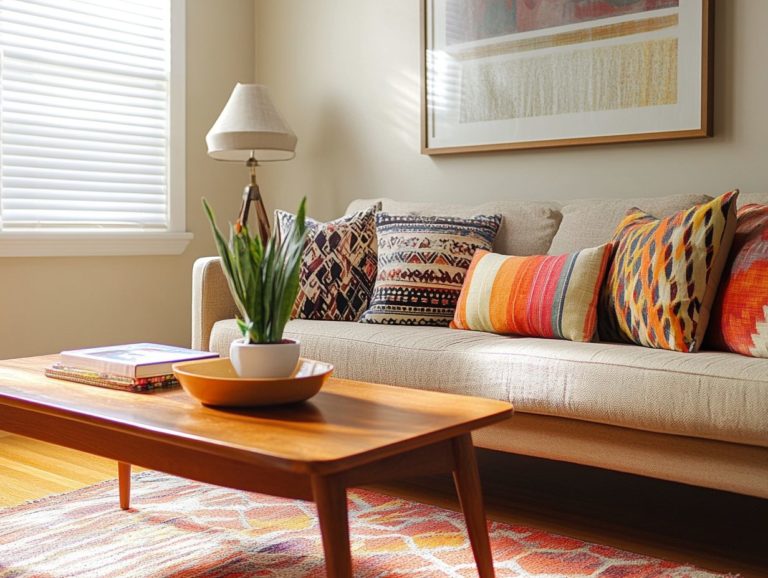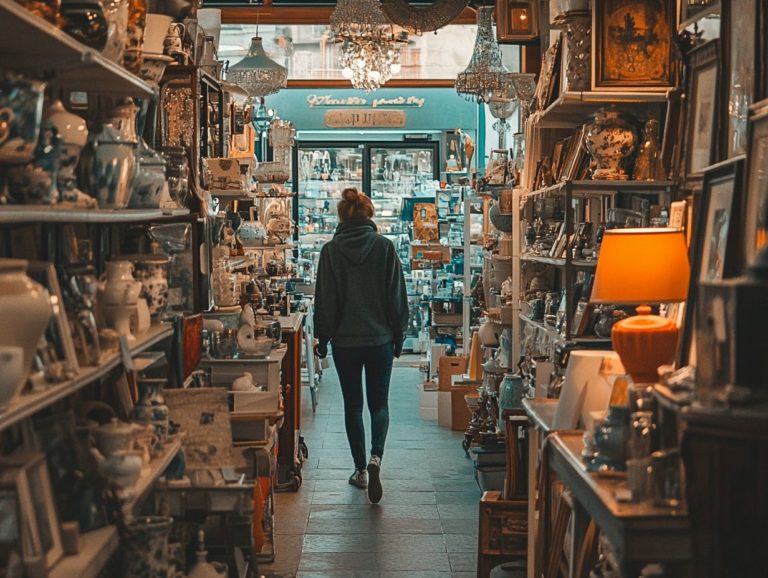How to Care for Vintage Home Textiles?
Vintage home textiles infuse a distinctive charm and character into any space. However, they require special care to maintain their enduring beauty.
Discover essential tips for cleaning and storing these cherished pieces. You will also find guidance on identifying and addressing common types of damage.
Whether you choose to restore them yourself or enlist professional help, explore innovative ways to showcase your collection. You’ll find strategies for preserving its value.
Dive into the art of caring for vintage textiles and elevate your space to new heights!
Contents
Key Takeaways:
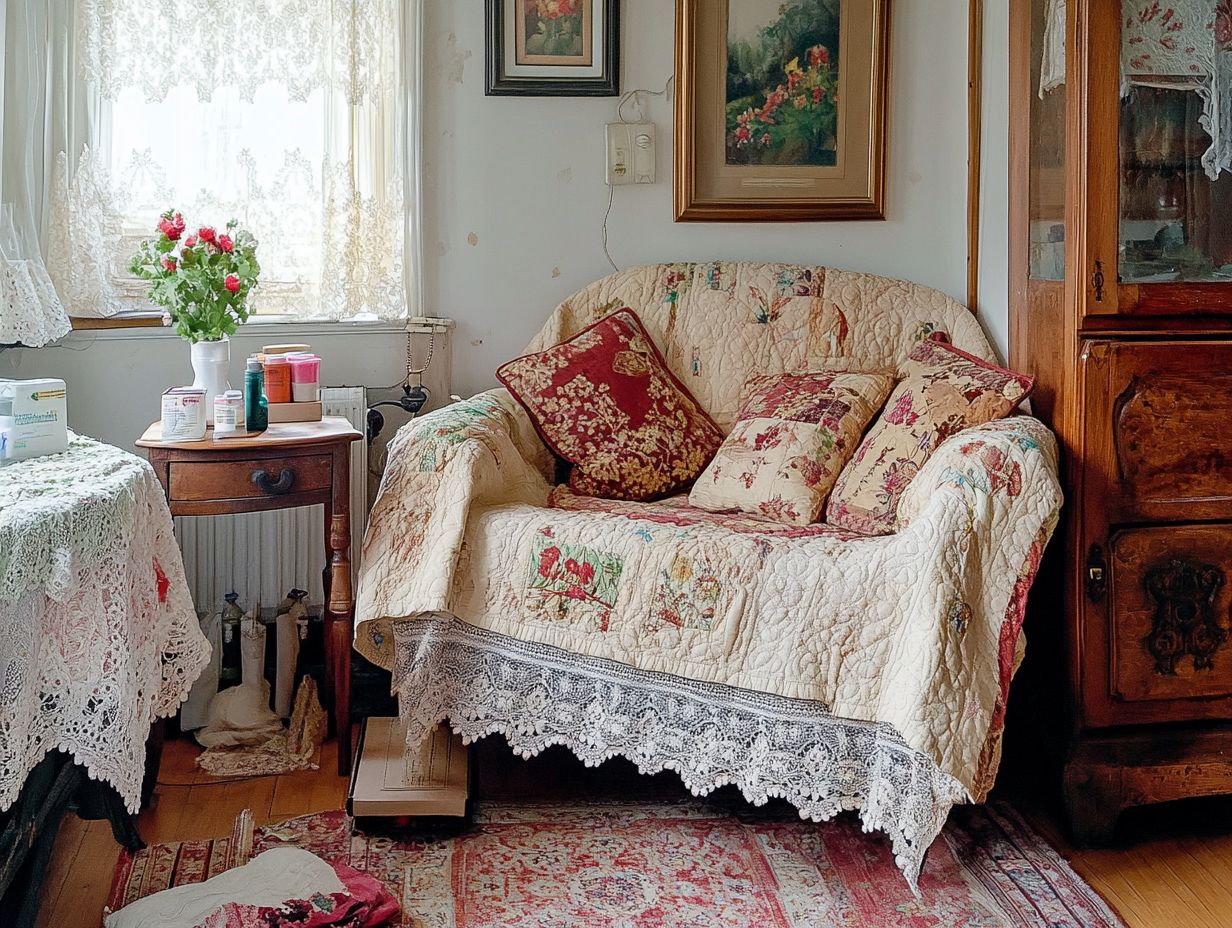
- Proper cleaning and storage are essential for maintaining the quality and longevity of vintage home textiles.
- Identifying and addressing damage early can help prevent further deterioration and preserve the value of your collection.
- From DIY techniques to professional services, there are various options for restoring vintage home textiles and bringing them back to their original beauty.
What are Vintage Home Textiles?
Vintage home textiles are a captivating realm of decorative fabric items that carry historical significance. They are often crafted before the mid-20th century.
This category includes a variety of textile treasures such as antique upholstery, 18th-century embroidery, and unique pieces like the Korean hierarchy badge and Victorian sampler. Each item showcases the artistry and craftsmanship of its era.
Vintage textiles serve not just as functional decor but also as historical artifacts that narrate the stories of their time.
From luxurious brocades to exquisite lace tablecloths, vintage home textiles reflect various cultures and traditions. Each textile tells a tale, revealing the social norms, artistic styles, and technological advancements of its time.
For example, the intricate patterns of an 18th-century embroidery piece showcase the techniques and materials available then. Similarly, ornate antique upholstery provides insights into the decorative preferences of affluent households.
By incorporating these vintage textiles into your modern decor or preservation efforts, you elevate your living space and pay homage to the rich heritage woven into each thread.
Caring for Vintage Home Textiles
Caring for vintage home textiles is crucial. They require specialized knowledge and careful handling due to their delicate nature.
These fragile items, such as antique upholstery or 18th-century embroidery, need your utmost attention. This helps prevent deterioration over time, ensuring they remain in pristine condition for future generations.
Expert conservators utilize a range of cleaning techniques tailored to the specific needs of each piece. Making the right choices is essential for their long-term preservation.
By adopting these practices, you can safeguard these treasures and honor their legacy.
Cleaning and Storage Tips
Proper cleaning and storage are essential for preserving the integrity and longevity of your vintage home textiles. This helps minimize risks like moisture damage and deterioration.
These vintage textiles are not just fabrics; they carry stories from the past that deserve your diligence in preservation. To protect them, always wash with gentle, pH-balanced detergents. Avoid harsh chemicals that could weaken the fibers over time.
For storage, use acid-free tissue paper to cushion these treasures and choose breathable bags. Avoid plastic, which can trap moisture and invite mold growth. Regularly inspect your stored textiles to catch any environmental issues early.
Maintaining proper climate control also helps protect these cherished items, ensuring they remain vibrant and intact for future generations to appreciate. Act now to protect these pieces of history!
Identifying and Addressing Damage
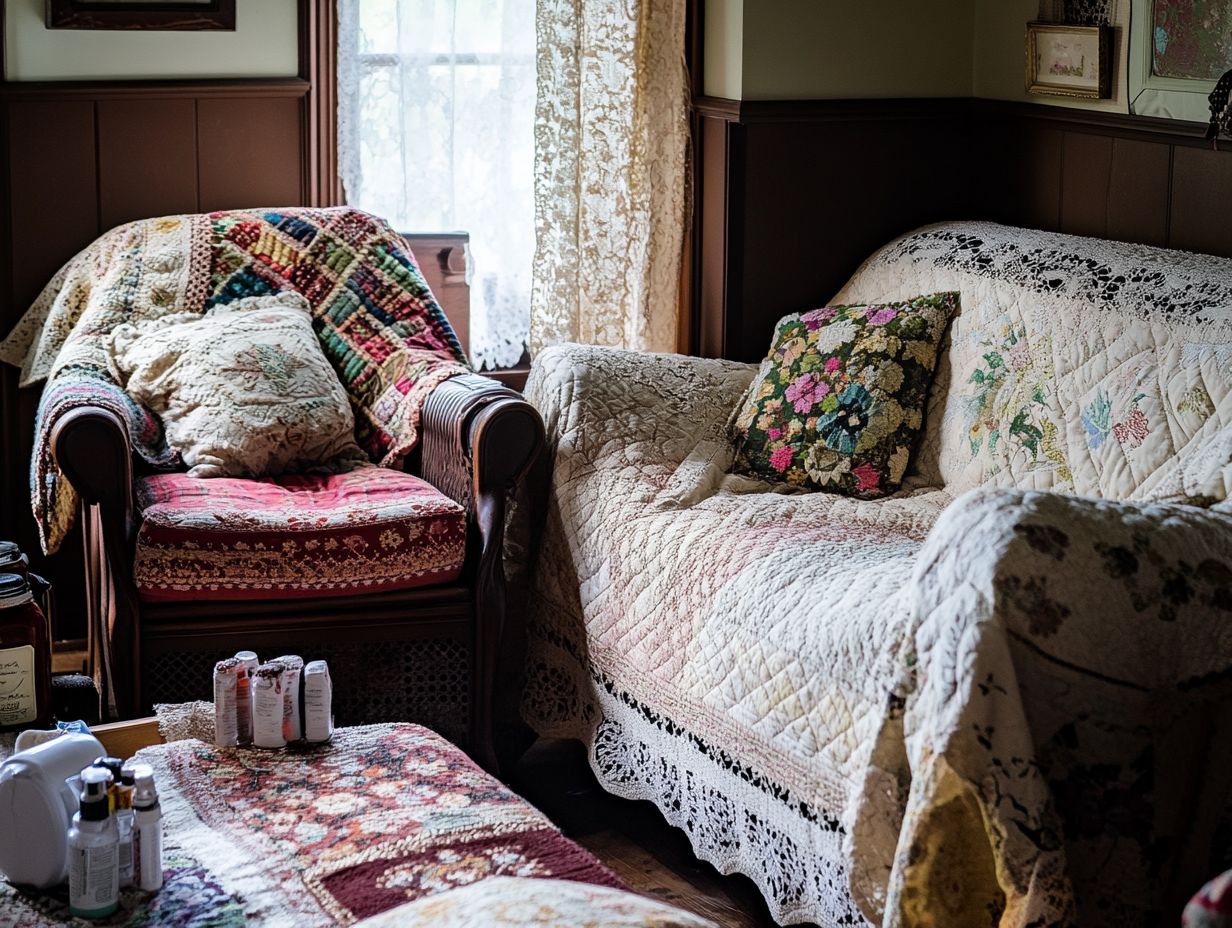
Identifying and addressing damage to your vintage home textiles is essential for their preservation. These valuable pieces often fall victim to various forms of deterioration. Common culprits include moisture damage, mold, and pests. These issues can significantly affect antique textiles like 15th-century embroidery or a 14th-century purse.
By spotting these issues early and taking necessary steps, you can greatly extend the lifespan of these cherished items, ensuring they continue to enrich your collection for years to come.
Common Types of Damage
Common types of damage to vintage home textiles can stem from various environmental factors and improper handling. These often lead to irreversible harm if not addressed promptly.
For example, exposure to direct sunlight can fade colors and degrade fibers over time, particularly in delicate pieces like embroidered tablecloths and antique lace curtains. Physical abrasion is another concern. This often happens during improper storage or frequent use, leading to frayed edges or thinning material.
To protect your prized textiles, consider taking steps such as using UV-filtering window treatments to shield them from harsh sunlight, maintaining controlled humidity levels to mitigate moisture issues, and storing items in breathable fabric bags instead of plastic.
By understanding these potential threats, you can ensure that your cherished pieces remain vibrant and intact for years to come.
Restoring Vintage Home Textiles
Restoring vintage home textiles is a thrilling adventure that breathes new life into your treasures. It allows you to honor their rich history while ensuring they remain both functional and visually captivating.
Whether you prefer to embark on DIY techniques or seek out professional conservation services, employing meticulous cleaning and restoration methods is crucial for reviving treasures like a 19th-century settee or 17th-century bishop’s gloves.
Expert conservators often customize their approaches to suit the unique materials and conditions of each textile. This guarantees that their restoration efforts uphold the integrity of these remarkable artifacts.
DIY Techniques and Professional Services
When you dive into the world of restoring vintage home textiles, combining DIY techniques with professional services can lead to truly exceptional results. It ensures these cherished items are preserved as they should be.
Taking on this challenge can be a rewarding experience. Engage in techniques like spot cleaning and gentle hand washing to maintain the integrity of delicate fabrics. However, recognize the limitations of your DIY efforts, especially with intricate embroidery or fragile lace that may need specialized care.
In these instances, reaching out to professionals who specialize in textile conservation can offer invaluable insights and methods to extend the life of these treasured pieces. Their expertise in materials and preservation techniques not only protects the fabric but also helps prevent irreversible damage. For more detailed guidance, you can refer to this comprehensive how to care for vintage textiles and fabrics. Striking the right balance between your personal care and expert intervention is vital for any successful restoration project.
Displaying Vintage Home Textiles
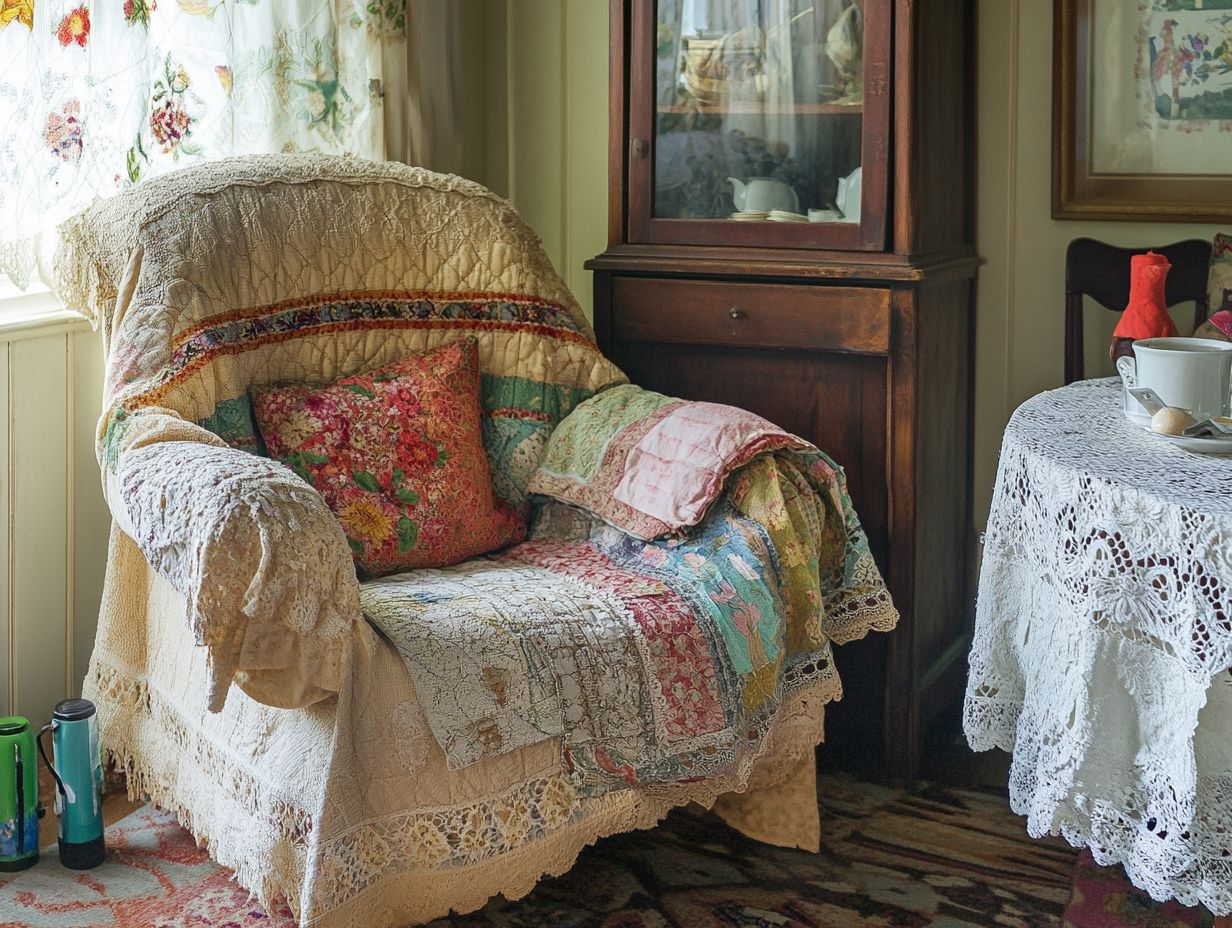
Displaying vintage home textiles can truly elevate your living space. It allows you to showcase the exquisite beauty and craftsmanship of these historical treasures. Whether you opt for UV protective framing to preserve delicate items like a Victorian sampler or choose to incorporate luxurious textiles such as Kimono silk into your d cor, there are countless creative avenues to highlight your collection.
Thoughtful display strategies enhance the aesthetic appeal and safeguard these fragile textiles from harmful light and various environmental factors. This ensures they remain as stunning as the day they were created.
Act now to start preserving your vintage textiles today!
Creative Ways to Showcase Your Collection
Creative ways to showcase your collection of vintage home textiles can truly elevate your interior design. These methods also help preserve the delicate integrity of these pieces. Consider using UV protective framing for items like 18th-century embroidery. You might also display a 14th-century purse in a shadow box. This not only shields them from harmful light exposure but also allows you to appreciate their beauty.
The key lies in striking a balance between visibility and preservation. Present these treasures in ways that honor their rich history.
A great approach is to layer textiles in a gallery-style wall display. Mix textures and colors to craft an engaging visual narrative. Don’t forget to use acid-free matting to guard against damage from acidity and environmental pollutants.
If you’re showcasing full garments, fabric mannequins are a brilliant choice. They display the piece elegantly and help maintain its shape over time.
For a more dynamic setup, consider creating a rotating exhibit. This allows different pieces to shine periodically, keeping your display fresh and engaging while extending the lifespan of your treasured vintage textiles.
Preserving the Value of Vintage Home Textiles
Preserving the value of vintage home textiles demands a proactive approach. It intertwines meticulous maintenance with protective measures to safeguard against deterioration. It s essential to comprehend the conditions around your textiles think about humidity, temperature swings, and harmful light exposure.
By implementing thoughtful strategies to mitigate these risks, you can take simple steps today to protect your treasures. Whether it s a beloved 19th-century settee or an exquisite Chinese silk panel, this dedication ensures their longevity and upholds their historical significance for years to come.
Tips for Maintaining and Protecting Your Collection
- Keep exquisite items like a Victorian sampler or a 14th-century purse away from moisture and temperature fluctuations.
- Don’t underestimate the value of UV protective measures.
- Consider professional conservation services when necessary.
- Control humidity levels; ideally, keep indoor humidity between 30% and 50%.
- Use acid-free storage materials, such as tissue paper and boxes, to shield your textiles from deterioration.
Regularly inspect your collection for signs of mold or pest damage; early detection can save you from costly repairs down the line.
Engaging with professional conservators adds another layer of expertise to your preservation efforts. Their specialized cleaning techniques and restoration work enhance the appearance of your textiles and solidify their significance for future generations.
Frequently Asked Questions
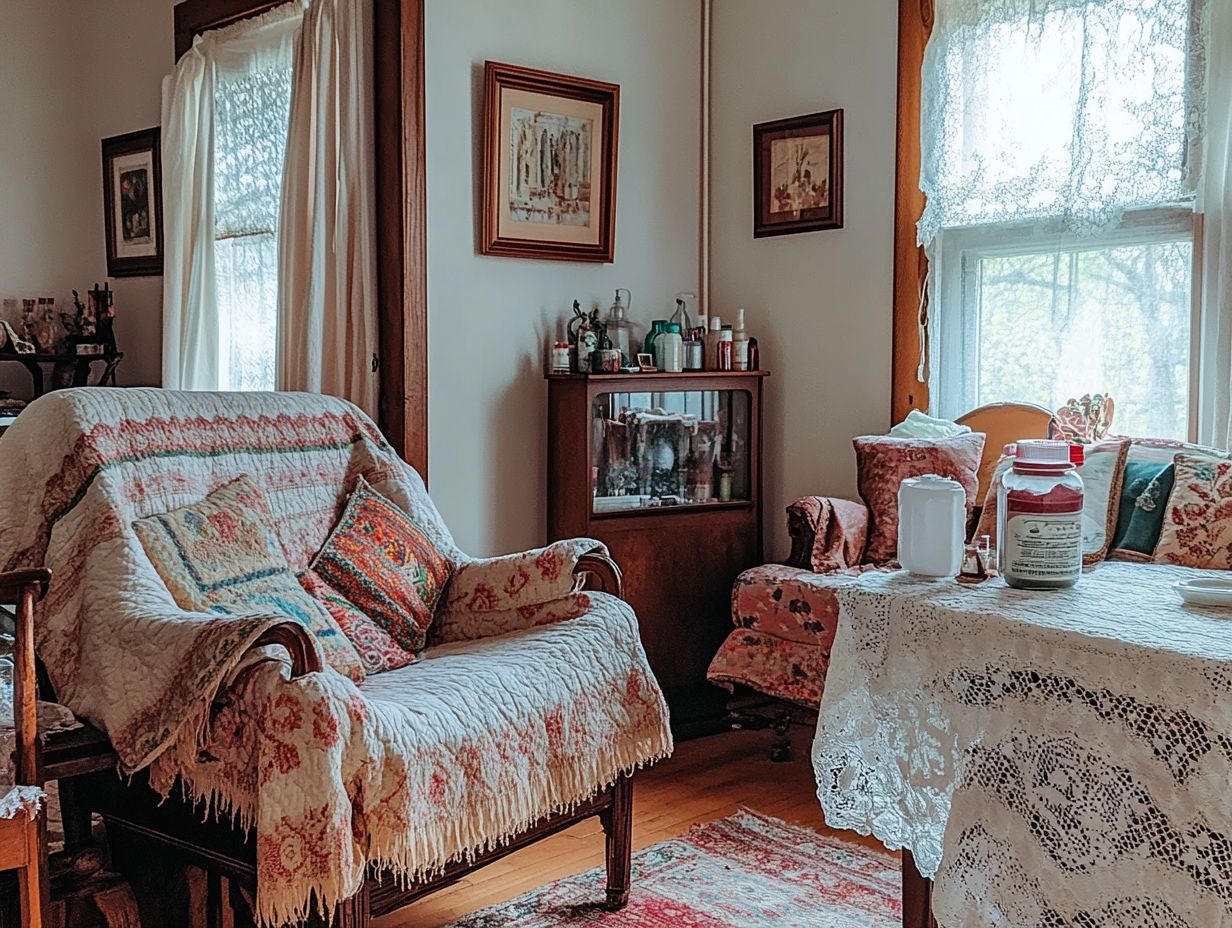
What are vintage home textiles and how do I know if I have them?
Vintage home textiles are any type of fabric or soft material used in a home that is at least 20 years old. This can include items such as curtains, tablecloths, pillowcases, and bedding. To know if you have vintage home textiles, look for characteristics such as unique patterns, hand-stitched details, or labels with dates or logos from past decades.
How should I clean vintage home textiles?
It is important to approach cleaning vintage home textiles with caution. Start by gently vacuuming the item to remove any dust or debris. If the item is washable, hand wash it in cold water with a mild detergent and lay it flat to dry. If the item is not washable, spot clean with a gentle cleaner and a soft cloth.
Can I use bleach on vintage home textiles?
No, it is not recommended to use bleach on vintage home textiles as it can weaken the fibers and cause discoloration or damage. Instead, opt for gentle cleaning methods or take the item to a professional cleaner who specializes in caring for delicate fabrics.
Start caring for your vintage textiles today!
How should I store vintage home textiles?
To preserve the quality of vintage home textiles, store them properly. Make sure the item is clean before storing it.
Fold the item carefully and store it in a cool, dry place. Keep it out of direct sunlight and extreme temperatures.
Wrap the item in acid-free tissue paper or place it in a muslin bag for extra protection.
What should I do if my vintage home textile has stains?
Treat stains on vintage textiles as soon as possible. Start by blotting the stain with a clean cloth to absorb excess liquid.
Use a gentle cleaner specifically made for fragile fabrics. Always test the product on a small, hidden area first.
Can I repair or alter vintage home textiles?
You can repair or alter vintage home textiles, but it s best to hire a professional. DIY repairs might cause more damage to the item.
Look for a seamstress or fabric specialist experienced with vintage textiles. They will ensure the item is handled with care.


